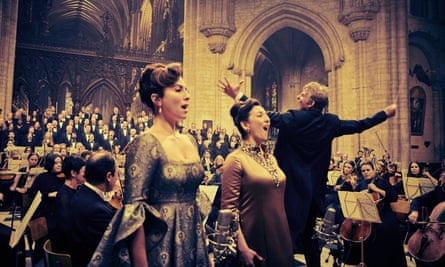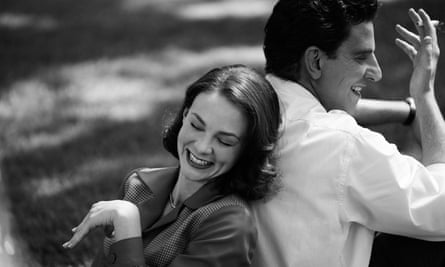
The camera, like its subject, is hyperactive in Maestro. It swoops and pirouettes. It drops into the middle of frantic conversations, with barely a pause for breath as Bradley Cooper charms and dazzles as Leonard Bernstein. This is Lenny in his 1950s and 60s heyday, building a life with Felicia, played by Carey Mulligan. He is prodigious in both talent and appetite, a man of restless contradictions.
What there is very little of is music. We barely see him conduct, we hear only snatches of his own compositions, and there are frustratingly few glimpses of his passion for communicating – through performance and education – the wonders and riches of classical music. Which is why one lengthy sequence near the end of Maestro is so powerful. When we do finally see him conduct, leading a performance of Mahler’s Second Symphony in Ely Cathedral, Cambridgeshire, Cooper shows us how Bernstein becomes the music, and the music becomes him.
This monumental scene, filmed over three nights and featuring the final 10 minutes of the 90-minute symphony, was recreated by today’s London Symphony Orchestra. Shaggy-haired and be-wigged (more of which later), they are back in the cathedral playing earlier incarnations of themselves – for it was this orchestra who performed at Ely with Bernstein back in September 1973.
The LSO’s relationship with the US conductor began in 1966, with a Mahler symphony which the then 47-year-old guest-conducted in the Royal Albert Hall, London. Two decades later, the orchestra mounted a hugely successful Bernstein festival in its new Barbican home, and the following year he was appointed its president, a position he held until his death at 72 in 1990. But many would argue that the high point of an enduring association with the orchestra came not in London but in Ely, now 50 years ago.
Bernstein, the LSO and a 150-strong choir travelled to the cathedral for a performance of the symphony, known as the Resurrection. That original concert was also filmed – Bernstein was recording all Mahler’s nine symphonies for a German company. The cycle was directed by his longtime collaborator Humphrey Burton, who went on to be his biographer. Other symphonies had been filmed in Vienna and Berlin, but Bernstein wanted to record the Resurrection, with its special religious quality, in Ely Cathedral.
“He had studied aesthetics at Harvard 30 years earlier,” Burton tells me, “and learned about Ely’s beauty and unique architecture. He always wanted to do a work here.” It was hugely expensive and logistically complicated, remembers Burton, but, “being Leonard Bernstein, his word was our command.”
In his 1994 biography, Burton writes: “It was a traumatic weekend of filming. A camera crane collapsed. A bomb scare ruined the dress rehearsal. The soundtrack was invaded by squeaking bats flying high in the magnificent octagon tower and crashing into the film lights. But the performance had an epic power that Bernstein never surpassed.”
Maestro omits the collapsing cranes and the squeaking bats, but the epic power is there. “Every orchestra loves playing that symphony, especially that last movement,” says violinist Clare Duckworth. “You can’t help but get swept along. The final take was amazing – our facial expressions are all genuine! A lot of the crew were in tears.” The orchestra performed the passage under the baton of both Cooper and Yannick Nézet-Séguin, the movie’s conducting adviser, who worked with Cooper for several years, not only teaching him to conduct but to conduct convincingly as Lenny.
Bernstein’s exuberance on the podium, a no-holds barred heart-on-sleeve embrace of the music’s emotional power, was one of his most famous characteristics. Watch footage of him conducting and you can see him airborne at points – the famous Lenny leaps. LSO cellist Alastair Blayden played under Bernstein while still a student in 1990. “When I heard we were to be conducted by him,” he says, “my jaw just dropped. It was like all my Christmases had come at once. As soon as he stood on the podium, there was a sense of connection that you get with a proper maestro – a sense of trust. Over 30 years later, I still hold by that sense of trust as being the mark of a true maestro. It’s very rare.”
Did Cooper convince? Yes, he says. “I did such a double-take when he walked into Ely Cathedral. The prosthetics are incredible. Apart from his height – Cooper is several inches taller.” And the conducting? Blayden and Duckworth agree that Cooper was plausible on the podium. “It’s hard enough conducting as yourself, let alone with someone else’s personality,” says Blayden. “But yes, he did pretty well. There were clear upbeats and downbeats – he knew the gestures and he obviously knew and loved the music.”
It was cold in the cathedral, says Duckworth. “We had handwarmers secreted about our persons, particularly the women, as we were kitted out in thin dresses.” She remembers Mulligan in Ugg boots sitting and simply listening when she wasn’t in shot. Every detail of the 1973 performance was painstakingly reproduced, from where each player sat (“more squashed than we generally are today!”), to the mocked-up programmes, even though these were never in shot.
Players who wore glasses were asked to provide prescriptions so they could be given new ones in old-style frames – and they were all asked to let their hair grow. “Most of the guys had been asked to grow beards,” says Duckworth, “and those with very short hair had been asked not to cut it.”
“Prior to the filming, we’d been on tour in Japan. We all came back looking like Robinson Crusoe!” laughs Blayden. “People were saying, ‘Wow, how long were you away for?’ The costume people tried me out with some sideburns but decided I looked too much like a hamster. Some colleagues went from shaved heads to being completely unrecognisable in wigs.” One glaring difference, however, between the 1973 LSO and today’s is the players themselves. The orchestra performing 50 years ago had only two women among 102 players: the harpists. Today’s group is 45% women.

Cooper wasn’t just channelling Lenny through extravagant conducting. Duckworth noted that he constantly had a cigarette in his hand or, when conducting, in his pocket. “And even though none of it was being captured on camera, when he was talking to the orchestra, he was talking in his Bernstein voice.”
Sue Mallet, the LSO’s director of planning, has worked for the orchestra for more than 50 years, which means that there are few conducting greats she hasn’t encountered. But, she says, “when anybody asks me who I feel most privileged to have worked with, I say Leonard Bernstein. He was a one-off.”
And yes, adds Mallet, the cigarettes were a constant. There are few shots in the movie in which Cooper is not smoking. “He would come off stage, have a tumbler of neat whisky and a cigarette. And that’s how he carried on until the day he died, I guess.”
But what about current LSO members who played with the real Bernstein? Andrew Pollock joined in 1984 and worked frequently with him. “He was a giant of music,” says the violinist. “When he was on the podium, he was phenomenal. He was living the music. He’d be dancing along. He was a fabulous conductor.” But off the platform, Pollock witnessed a less fabulous side. “He could be cantankerous and really objectionable,” he says.

Pollock recalls a reception to welcome Bernstein as orchestra president. “We were all encouraged to introduce ourselves. He was sitting sprawled at a table, with a cigarette in one hand and a drink in the other. I went up and said, “Hello, Mr Bernstein, wonderful to have you here.’ And he just looked up at me and said with total disdain, ‘Who the fuck are you?’ He was just like that – he loved to put people down. I was completely astonished.”
Burton’s biography adds some context: “By the mid-1980s, there were times when his behaviour was less attractive. As his daughter Jamie remembers, ‘He was doing more Scotch and relying more heavily on his Dexedrine.’ When he mixed the drug and the alcohol, he ‘would have a personality change … he would get vituperative and irritable and snap at people and say awful things and bang the table and throw lit cigarettes at us … It got to the point that Daddy being a pain in the ass was the norm and when he was fun to be around became a nice special exception. After mother was gone … there was no one to check him except us and there were limits for us because we didn’t live with him. So after that it was just Maestro City all the way.”
“He was larger than life. There is no doubt he was out to shock,” says Mallet, remembering the 1990 tour in Japan when his fans would greet him in his dressing room after the concert. “He would be wearing a men’s kimono that would be undone to his navel. And all these Japanese ladies didn’t know where to put themselves.”
On another tour in Vienna, Mallet adds, Lenny invited some LSO staff to a Halloween party. “We walked into a room full of beautiful and strange people. Lenny was lying on a chaise longue with somebody sitting at one end massaging his feet and somebody at the other end feeding him grapes. He was in a white cashmere jumpsuit and he said to me, ‘You know what, Sue? This jumpsuit, there are only two, and the other one is owned by the pope!”
She laughs, shaking her head. “Yes, it’s bonkers, isn’t it? But that was Lenny.”

More troublingly, perhaps, Pollock remembers a performance in London of Bernstein’s own Chichester Psalms with a 15-year-old Aled Jones. “The way Bernstein drooled over him was disgusting. You simply couldn’t behave in that way today. And he’d be kissing people in the orchestra.”
“If he went up to kiss anybody, it was a smack on the lips,” says Mallet. No one liked it, says Pollock, but only one player ever complained. It was, they both agree, a different time.
Bernstein was a complex and flawed character, but a phenomenal and sensational musician. Music, says Pollock, just seemed to ooze out of his every pore. And the audiences loved him. “He was like a magnet for people of both sexes,” says Mallet. “I know he could be caustic, but I always found him charming, professional and above all kind. He would love to go out to dinner after a concert and he would have 20 people at a table spellbound.” It sounds like there was no off button? “If there was, I certainly didn’t find it.”






